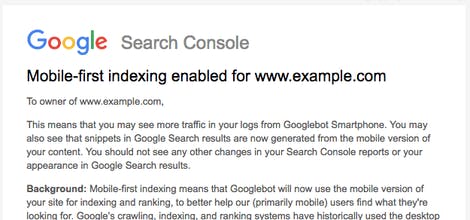Mobile-first indexing is…
First things first. What is mobile indexing? As the name suggests, mobile-first indexing is an indexing system under which Google will “predominantly” look at a mobile version of a site’s content for indexing and ranking. The rationale for this is simple: most Google users now access the search engine through a smartphone so, where appropriate, Google should prioritize the content that mobile users see when it crawls sites.
Google will still have one index
It’s important to note that Google has not created a separate index for the content it crawls using mobile-first indexing. The company will continue to maintain a single index. Mobile-first indexing is merely a change to the way Google adds content to that index.
A lot of sites won’t be affected
Mobile-first indexing is an important development, but many sites won’t be affected by it. Most notably, sites that use a responsive design won’t be subject to mobile-first indexing because their content is the same on desktop and mobile. Also not impacted: sites that only have a desktop version and canonical AMP pages.
The sites that will be affected by mobile-first indexing are those that use separate URLs for desktop and mobile users, and those that serve content dynamically based on device type.
Those affected will want to heed Google’s best practices
Sites that will experience mobile-first indexing should take care to review and implement the best practices Google has published.
Search Console is being used for notifications
Google will be letting site owners know that mobile-first indexing has rolled out to their sites via notifications in Search Console.

Crawl rates from the Smartphone Googlebot will increase
Google says that sites subject to mobile-first indexing will see increased crawl rates from the Smartphone Googlebot, so it’s a good time to check that robots.txt directives are appropriate for mobile sites and to ensure that there’s enough capacity to handle higher crawler traffic.
Mobile-first indexing doesn’t affect ranking
As noted above, mobile-first indexing changes the way Google adds content to its index. It does not change the way that Google ranks pages.
As Fan Zhang, a Google software engineer, explained, “Content gathered by mobile-first indexing has no ranking advantage over mobile content that’s not yet gathered this way or desktop content.” He did, however, stress the importance of mobile-friendly content, adding, “We do evaluate all content in our index — whether it is desktop or mobile — to determine how mobile-friendly it is. Since 2015, this measure can help mobile-friendly content perform better for those who are searching on mobile.”
Desktop content will continue to be indexed
While it’s increasingly difficult for companies to avoid offering a mobile-friendly site, those that still only have a desktop site need not worry: Google isn’t doing away with the indexing of desktop content.
Mobile-first indexing extends to the SERPs and Google cache
Because it alters the way Google adds content to its index, it’s no surprise that sites affected will have their mobile pages displayed in search results, as well as in the Google cache, a reminder of the importance of making sure that mobile pages have the same content, including metadata and structured data, as desktop pages.
Further reading:


Comments